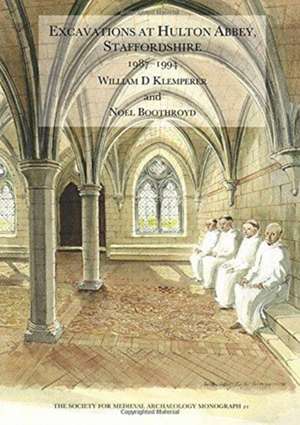Excavations at Hulton Abbey, Staffordshire 1987-1994: The Society for Medieval Archaeology Monographs
Autor William D. Klemperer, Neil Boothroyden Limba Engleză Paperback – dec 2004
Din seria The Society for Medieval Archaeology Monographs
-
 Preț: 285.57 lei
Preț: 285.57 lei - 23%
 Preț: 410.54 lei
Preț: 410.54 lei -
 Preț: 360.53 lei
Preț: 360.53 lei -
 Preț: 416.22 lei
Preț: 416.22 lei - 25%
 Preț: 774.76 lei
Preț: 774.76 lei - 16%
 Preț: 244.13 lei
Preț: 244.13 lei - 11%
 Preț: 304.66 lei
Preț: 304.66 lei -
 Preț: 408.37 lei
Preț: 408.37 lei -
 Preț: 406.93 lei
Preț: 406.93 lei - 16%
 Preț: 251.60 lei
Preț: 251.60 lei - 14%
 Preț: 275.96 lei
Preț: 275.96 lei - 16%
 Preț: 241.15 lei
Preț: 241.15 lei - 17%
 Preț: 259.98 lei
Preț: 259.98 lei - 16%
 Preț: 265.51 lei
Preț: 265.51 lei -
 Preț: 406.91 lei
Preț: 406.91 lei - 21%
 Preț: 380.38 lei
Preț: 380.38 lei - 12%
 Preț: 271.66 lei
Preț: 271.66 lei - 12%
 Preț: 303.79 lei
Preț: 303.79 lei - 15%
 Preț: 267.34 lei
Preț: 267.34 lei - 14%
 Preț: 285.35 lei
Preț: 285.35 lei - 11%
 Preț: 300.09 lei
Preț: 300.09 lei - 30%
 Preț: 830.51 lei
Preț: 830.51 lei
Preț: 332.17 lei
Preț vechi: 421.47 lei
-21% Nou
Puncte Express: 498
Preț estimativ în valută:
63.56€ • 66.53$ • 52.90£
63.56€ • 66.53$ • 52.90£
Comandă specială
Livrare economică 10-24 martie
Doresc să fiu notificat când acest titlu va fi disponibil:
Se trimite...
Preluare comenzi: 021 569.72.76
Specificații
ISBN-13: 9781904350309
ISBN-10: 1904350305
Pagini: 236
Ilustrații: b/w figs and pls, 2 col pls
Dimensiuni: 210 x 297 x 18 mm
Greutate: 0.88 kg
Ediția:1
Editura: Taylor & Francis
Colecția Routledge
Seria The Society for Medieval Archaeology Monographs
Locul publicării:Oxford, United Kingdom
ISBN-10: 1904350305
Pagini: 236
Ilustrații: b/w figs and pls, 2 col pls
Dimensiuni: 210 x 297 x 18 mm
Greutate: 0.88 kg
Ediția:1
Editura: Taylor & Francis
Colecția Routledge
Seria The Society for Medieval Archaeology Monographs
Locul publicării:Oxford, United Kingdom
Cuprins
List of figures Preface Summary Acknowledgements 1. Introduction 1.1 The Cistercians (by W D Klemperer) 1.2 Monasticism in Staffordshire (by N Boothroyd) 1.3 The history of Hulton Abbey (by W D Klemperer) 1.4 Carmountside Farm to 1884 (by A Nicholls) The abbey site after the Dissolution The first Carmountside Farm The rebuilding of Carmountside Farm 1.5 The re-discovery of the site and excavations after 1884 (by W 0 Klemperer and A Nicholls) 2 The excavations 1987-94 (by W D Klemperer) 2.1 Evaluation of the outer court 2.2 Excavations in the church and chapter house 2.3 The chapter house, bookstore and sacristy (area BH) The bookstore and sacristy The chapter house 2.4 The south transept (area BB) Phase BB2: construction Phase BB3: medieval Phase BB4: post-medieval2.5 The crossing (area BF) Phase BF2: construction Phase BF3: early graves Phase BF4: medieval timber structure Phase BF5: construction of the choir stalls, a screen and further burials Phase BF6: Dissolution 2.6 The north transept (area BG) Phase BG2: construction Phase BG3: medieval floors Phase BG4: medieval graves Phase BG5: demolition or collapse Phase BG6: stone robbing and post-Dissolution soil build up Phase BG7: mid 19th century to modern 2.7 The nave and aisles (area BO) Phase BOI: before the abbey Phase B02: construction and early features Phase BD3: new floor, chapels at the west end and early burials Phase B04: remodelling of the west end Phase B05: a new floor and associated burials Phase B06: pre-Dissolution Phase B07: evidence for the Dissolution Phase B08: post-Dissolution decay of the church Phase B09: post-medieval disturbance Phase BOlO: late 19th century onwards 2.8 The west court and west range (area BC) Phase BC2: construction Phase BC3: medieval Phase BC4: Dissolution debris and destruction Phase BC5: demolition or collapse Phase BC6: modern, including Lynam's excavations of 1884 2.9 The chancel/north transept external angle (area BE) Phase BE2: construction Phase BE3: medieval Phas
Descriere
Of the three Cistercian houses in north Staffordshure, Hulton Abbey is the only one to have been properly investigated. Founded in 1219, it was a poor monastic house which was dissolved in 1538.
